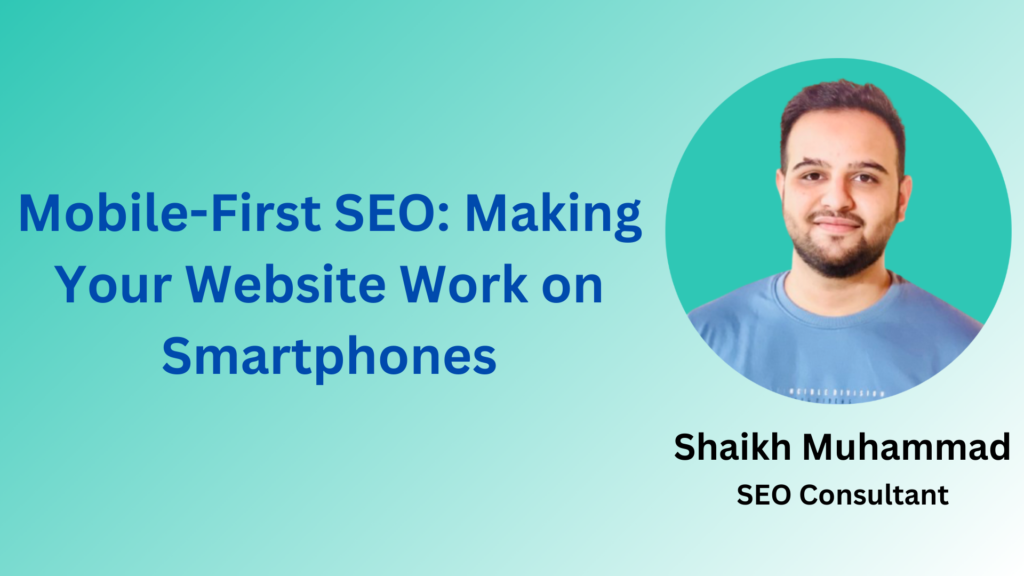Mobile-First SEO: Making Your Website Work on Smartphones

Understanding the Shift to Smartphone-Optimized Search
Why Mobile Search Matters Today
With over 60% of searches now happening on mobile devices, mobile first SEO has become crucial for online success. The shift in user behavior has fundamentally changed how businesses need to approach their digital presence and search optimization strategies. Mobile users exhibit distinct behavior patterns, often searching with immediate intent and expecting instant gratification. This behavioral shift has prompted search engines to prioritize mobile-optimized content, making mobile-first optimization not just an option but a necessity for maintaining and improving search visibility.
Key considerations:
- Mobile traffic surpassed desktop traffic in most industries
- Google prioritizes mobile-friendly websites in rankings
- Mobile users have different search intents and behaviors
- Conversion patterns differ significantly on smartphones
How Search Engines Process Phone-Friendly Pages
Search engines now primarily use mobile versions of content for ranking and indexing. Understanding this mobile-first indexing approach is essential for maintaining and improving search visibility. Google’s mobile-first indexing means that the mobile version of your website becomes the starting point for what Google includes in their index and the baseline for how they determine rankings. This fundamental change in search engine behavior requires a complete rethinking of how we approach website optimization, prioritizing mobile experience without sacrificing desktop functionality.
Technical aspects include:
- Mobile-first crawling patterns
- Smartphone agent rendering
- Mobile content evaluation
- Phone-specific ranking signals
Core Benefits of Mobile-First Design
A mobile-first approach delivers advantages beyond just search rankings. It creates a foundation for better user experience and higher engagement across all devices. By prioritizing mobile design, businesses naturally focus on essential content and functionality, leading to cleaner, more efficient websites overall. This approach often results in improved performance metrics across all devices, as the constraints of mobile design encourage better optimization practices and more thoughtful content presentation.
Primary benefits:
- Improved user engagement metrics
- Lower bounce rates on mobile devices
- Higher conversion rates for smartphone users
- Better cross-device consistency
Technical Foundation for Mobile SEO
Responsive Design Implementation
Responsive design ensures your website adapts seamlessly to any screen size. This approach uses fluid grids and flexible layouts to create a consistent experience across devices. Modern responsive design goes beyond simple scaling — it involves thoughtful consideration of content priority, navigation patterns, and interaction models across different device sizes. The implementation requires careful planning of breakpoints that align with common device dimensions while ensuring the design remains flexible enough to accommodate future screen sizes.
Essential elements:
- Flexible grid systems
- Breakpoint optimization
- Image scaling solutions
- CSS media queries
Mobile Page Speed Optimization
Page speed significantly impacts both user experience and search rankings on mobile devices. Fast-loading pages are crucial for maintaining user engagement and improving conversion rates. Research shows that 53% of mobile users abandon sites that take longer than three seconds to load. This makes speed optimization a critical factor in mobile SEO success. Additionally, mobile networks’ variable nature means that speed optimization must account for different connection qualities and types.
Speed optimization tactics:
- Code minification
- Resource compression
- Browser caching setup
- Server response optimization
Touch-Friendly Navigation Elements
Navigation design must accommodate touch interfaces while maintaining usability. Elements need to be easily tappable without sacrificing aesthetic appeal. This includes understanding the physical limitations of finger-based interaction and the importance of providing clear visual feedback for all interactive elements. Touch targets must be sized appropriately for human fingers while maintaining a clean, uncluttered interface that works across various device sizes and orientations.
Design requirements:
- Minimum touch target sizes
- Adequate spacing between elements
- Clear visual feedback
- Intuitive gesture controls
Viewport Configuration Best Practices
The viewport meta tag serves as the cornerstone of responsive design implementation, directly influencing how mobile browsers interpret and scale your web pages. Proper configuration ensures content displays appropriately across different screen sizes and devices while maintaining readability and usability. This technical foundation affects everything from text scaling to touch target accessibility, making it a crucial element of mobile-first design.
Configuration elements:
- Meta viewport tag implementation
- Content scaling rules
- Orientation handling
- Device-specific adjustments
Content Optimization for Small Screens
Writing for Mobile Readers
Mobile content consumption differs fundamentally from desktop reading patterns. Users on mobile devices typically scan content in shorter bursts, making it crucial to adapt your writing style accordingly. Research indicates that mobile users read 20–30% slower on mobile devices, yet they expect to find information more quickly. This paradox requires a careful balance between comprehensive information delivery and concise presentation, emphasizing the need for scannable, well-structured content that delivers value efficiently.
Writing guidelines:
- Short, focused paragraphs
- Clear headings and subheadings
- Bullet points for key information
- Front-loaded important content
Visual Content Scaling
Visual content plays a crucial role in engagement but must be optimized thoughtfully for mobile devices. The challenge lies in maintaining visual impact while ensuring fast loading times and appropriate scaling across different screen sizes. Modern image optimization techniques, combined with responsive design principles, allow for dynamic content delivery that adapts to both device capabilities and network conditions, ensuring an optimal viewing experience without compromising performance.
Scaling considerations:
- Responsive image techniques
- Video embedding best practices
- SVG usage for graphics
- Lazy loading implementation
Small Screen Search Features
Mobile Rich Results
Rich results have become increasingly important in mobile search, where screen real estate is at a premium. These enhanced search listings can significantly improve visibility and click-through rates. Implementation requires careful attention to structured data markup while considering how these results appear specifically on mobile devices. The key is to optimize for mobile-specific rich results features while ensuring they degrade gracefully across all platforms.
Implementation priorities:
- Schema markup optimization
- Mobile-specific rich snippets
- Visual enhancement opportunities
- Performance monitoring systems
Progressive Web Apps
Progressive Web Apps (PWAs) represent the evolution of mobile web experiences, bridging the gap between traditional websites and native applications. They offer offline functionality, push notifications, and app-like interactions while maintaining the accessibility of web content. This technology particularly benefits mobile SEO by improving engagement metrics and providing a more robust user experience that search engines increasingly value.
Key PWA elements:
- Service worker implementation
- App manifest configuration
- Offline functionality
- Push notification setup
Testing and Monitoring Mobile Performance
Mobile Usability Testing
Comprehensive mobile usability testing requires a systematic approach that considers both technical metrics and real-world user behavior. Testing must account for various devices, operating systems, and usage conditions to ensure consistent performance. This involves combining automated testing tools with real user testing sessions to identify and address potential issues before they impact search performance or user experience.
Testing protocols:
- Cross-device compatibility checks
- User journey mapping
- Performance metric monitoring
- Accessibility validation
Cross-Device Compatibility
Cross-device compatibility extends beyond simple responsive design to ensure consistent functionality across different platforms and browsers. This requires thorough testing across various devices, operating systems, and browsers to identify and resolve potential compatibility issues. The goal is to maintain a consistent user experience while taking advantage of platform-specific features when available.
Compatibility checklist:
- Browser testing matrix
- Feature detection implementation
- Fallback solution development
- Platform-specific optimizations
Advanced Mobile Optimization
Dynamic Serving Solutions
Dynamic serving represents a sophisticated approach to delivering optimized content based on user context. This method allows for highly customized experiences while maintaining SEO benefits. The implementation requires careful configuration to ensure proper device detection and content delivery while avoiding common pitfalls that could negatively impact search performance.
Implementation requirements:
- User agent detection
- Content variation management
- Header configuration
- Cache optimization
International Mobile SEO
International mobile SEO combines the complexities of mobile optimization with the challenges of international targeting. This requires careful consideration of language, location, and cultural factors while maintaining mobile-first principles. Success depends on implementing proper hreflang tags, managing URL structures, and ensuring content is appropriately localized while maintaining mobile optimization.
International considerations:
- Hreflang implementation
- Regional content adaptation
- Mobile market research
- Local device preferences
Mobile E-commerce Features
Mobile e-commerce requires special attention to conversion optimization while maintaining strong SEO practices. The focus must be on creating seamless shopping experiences that accommodate mobile user behavior patterns while ensuring proper indexing and visibility in search results. This includes optimizing product pages, checkout processes, and navigation specifically for mobile users.
E-commerce optimizations:
- Mobile checkout optimization
- Product page speed
- Mobile payment integration
- Cart abandonment reduction
Mobile Analytics Setup
Proper mobile analytics configuration is crucial for understanding and improving mobile SEO performance. This involves setting up comprehensive tracking that captures mobile-specific metrics while providing actionable insights. The focus should be on measuring both technical performance and user behavior metrics to guide optimization efforts.
Analytics essentials:
- Mobile-specific event tracking
- User flow analysis
- Conversion path monitoring
- Custom mobile reporting
♻️ Share if you find value in this or you think someone else will find value in this!
📌Subscribe my FREE SEO Toolkit newsletter
Shaikh Muhammad is an SEO consultant. He helps businesses and blogs to rank higher in Google SERP’s.


